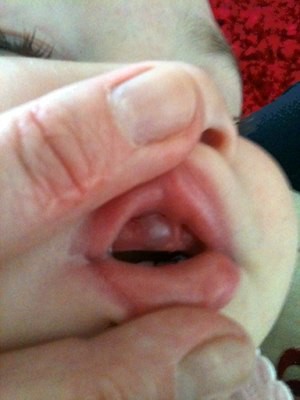 Many parents worry when they find that their young child or baby has a bluish purple bump on their gums. This is a fairly common development and is known as an eruption cyst or eruption hematoma. For uniformity throughout the article, I will simply refer to them as eruption cysts.
Many parents worry when they find that their young child or baby has a bluish purple bump on their gums. This is a fairly common development and is known as an eruption cyst or eruption hematoma. For uniformity throughout the article, I will simply refer to them as eruption cysts.
What Are Eruption Cysts?
The easiest way to describe eruption cysts is by talking about how teeth develop. Your child's teeth form inside of a protective enclosure in their jaw bone. When the teeth are done forming, they start to move through the bone, and then through the gums until they make it into the mouth. An eruption cyst occurs during the tooth's final entry into the mouth - after it has already made its way through the bone and is just under the surface of the gums.
The protective enclosure which the tooth developed in can leak and allow fluid to accumulate between the tooth and the gums. If an opposing tooth touches the gums, it may cause fluid and possibly blood to accumulate between the tooth and the gum. This causes a bruise to form in the gum tissue between the tooth and the outside surface of your child's gums. Depending on the amount of blood that accumulates in the eruption cyst, it can be a translucent color, bluish purple, or even dark red and brown.
Although they are unattractive and often cause parents to worry, most eruption cysts are actually painless.
What Causes Eruption Cysts?
The most widely-accepted theory is that eruption cysts are caused by trauma to the gums a few weeks before a new tooth comes in. The trauma doesn't have to be severe — McDonald & Avery's Pediatric Dentistry states that the trauma occurs as a result of normal chewing.
Another reason eruption cysts occur is due to thickened gum tissues. This can result from taking certain medications. Neville's Oral Pathology textbook hypothesized that one reason eruption cysts occurred in a young child taking cyclosporin was due to "collagen deposition in the gingival connective tissue that resulted in a thicker, less penetrable, pericoronal roof." With thicker gums, it may have been more difficult for the tooth to erupt into the mouth, causing an eruption cyst.
Who Can Get Eruption Cysts?
Any child can get an eruption cyst before their tooth erupts into the mouth. As far as race goes, they are reported to be most common in Caucasian children and they are just as common in boys as in girls.
How Common Are Eruption Cysts?
Nobody knows. A scholarly article has state, "Prevalence of eruption cyst has not been thoroughly studied. Extensive review of literature revealed low prevalence of these cysts."
Many parents may not notice that their child has an eruption cyst or may simply do nothing about it and then note that it goes away. Due to the fact that many eruption cysts are not documented very well, it's hard to pinpoint an exact percentage when it comes to how common eruption cysts are.
In an exam of 1,211 children from a Brazilian hospital, it was found that 2 of them had eruption cysts. That's only 0.17% that had eruption cysts at the time that they were examined. However, many more of these children may have had eruption cysts before they were examined. This would lead me to believe that eruption cysts are much more common than 0.17%.
Where Do Eruption Cysts Occur?
Although it has been debated, most articles (like this one) state that eruption cysts occur most commonly in the upper jaw. They most commonly occur with the baby incisors, the baby molars, and the permanent first molars.
How Are Eruption Cysts Treated?
Normally eruption cysts don't need treatment. The tooth will usually break through the cyst within a few days come into the mouth on its own. If the eruption cyst persists in the mouth for more than a few weeks, many dentists will make a small incision in the cyst which will allow the tooth to come through. Depending on the anxiety level of your child, this procedure can usually be done under local anesthesia.
What Else Could It Be?
When we see a swelling over a tooth that is about to erupt, we usually think of eruption cysts. It is possible that it could be something else though, such as a calcifying odontogenic cyst. This case report states, "Other lesions that can cause gingival swellings include peripheral giant cell granuloma, peripheral ossifying fibroma, pyogenic granuloma, and other less common peripheral odontogenic tumors."
Questions?
Do you have any questions, comments, or concerns about eruption cysts? Feel free to leave a comment in the comments section below.
I want to especially thank Leigh for sharing the above photo of her 8 month old daughter's eruption cyst. If anyone else wants to share their photo, you can email them to OralAnswers at Gmail.com or use this contact form. Thanks for reading!
Related posts:
- Seven Reasons Your Gums Are Enlarged
- Bleeding Gums When Brushing and Flossing: Is It Normal?
- What a Baby’s Gums Look Like While Teething
Source: http://feedproxy.google.com/~r/OralAnswers/~3/wh-nwIF94YI/
implants dental dental services implant dental dental implant oral surgeon
No comments:
Post a Comment